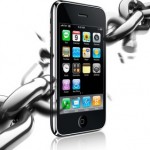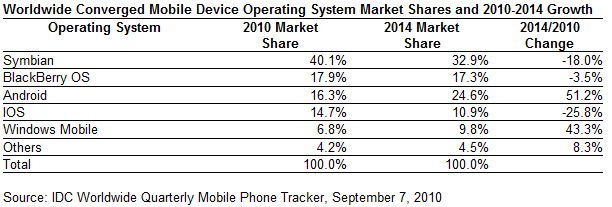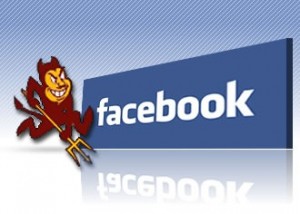 IDC released their worldwide quarterly numbers for mobile device operating system market share last week, and whether you look at the current market, or the predicted 2014 market, it doesn’t look good for Apple.
IDC released their worldwide quarterly numbers for mobile device operating system market share last week, and whether you look at the current market, or the predicted 2014 market, it doesn’t look good for Apple.
The skinny: Android is kicking Apple’s ass.
To figure out why, let’s go back in time, to January of 2007. Apple releases the original iPhone, and the usual suspects of Apple-loving zealots (the crowd that buys and loves *EVERYTHING* that Apple makes) buys one, and shows their friends. Some of these friends end up being real people, not already drinking the Apple kool-aid, and they realize pretty quickly that Apple was onto something big here.
Much like they did with the iPod, Apple entered the mobile phone game at a time when the technology had matured enough to truly make a “smart phone”, where some tasks that we previously relied solely on our PC’s and laptops for, started to make sense in our pockets if done right. The iPhone did them right, from the web to rich email, youtube, maps, and eventually: apps.
Within a year, since Apple successfully proved the fees-ability of a “smart phone” to the mass market beyond early adopters and business users, everyone and their brother in the carrier and handset business tried to copy their success. They all failed. . . miserably. Why buy the imitation handset, with imitation OS tied to it, when you can buy the original. Google however, in their infinite wisdom, and with their deep pockets attacked from a different angle and started developing Android, a mobile OS that would run on not just their own hardware, but hardware from other vendors that chose to license it (or license the functionality of a “store” for apps, etc.) By this time, Apple had amassed zillions of apps in it’s own app store, and had a pretty damn big chunk of market share. The general public, if they could afford it, had totally adopted the idea of “smart” in their pocket, and everyone wanted an iPhone.
In October of 2008, Google rolls out Android, and all the “Apple haters” that secretly wanted an iPhone, but wouldn’t be caught dead with anything Apple-branded, instantly buy an Android device and start consuming/writing Android apps. It takes a while, but adoption gains traction, and the UI becomes friendlier, more stable, and more standard. Most important of all, carriers and handset vendors, still licking the wounds from their failed-iPhone-copycat-devices start seeing that you CAN compete with Apple’s iPhone, you just have to work together.
Fast-Forward to present day, late summer 2010. Apple had a rocky iPhone 4 release (antennagate, pre-order hell, etc.), and the folks that bought an iPhone, but aren’t married to Apple otherwise are starting to get sick and tired of Apple telling them which apps they can and can’t run. This didn’t matter so much when they were the only game in town, but now there’ s competition, and it’s looking a whole lot more “open” on the other side of the fence.
Need proof? Here’s the chart from IDC:

Let’s just concentrate on the 2010 column for now. Android commands 16.3% of the market, while Apple holds 14.7%. Symbian, the 800lb gorilla here is almost irrelevant since the 40.1% they hold reflects folks with std. handsets no different that what’s been out for the last 10+ years. I view all of these as consumers that will eventually be buying Android devices, iPhone’s or Windows Mobile devices.
What about BlackBerry? Personally speaking, I think they’re on their way out. Their time has come and gone, and unless they do something drastic like re-write their UI to run on Android, and license the Android app store. . goodbye.
Windows Mobile has probably the best shot at gaining some of that Symbian market share alongside iPhone and Android. Their previous mobile OS’s have been such shit, that at this point the fact that they’re brazen enough to even release the next version has a lot of people convinced they’ve done their homework this time. I guess the jury’s out until Windows Mobile 7 is 3-6 months into release and the numbers talk, and we see if they can carve out a space for a 3rd app “store”.
Apple biggest strength in this game is their biggest weakness. It’s their private, locked-gate community built atop their closed OS and tightly-controlled app store. While cautious parents, and technology illiterate consumers love the ease of knowing that most of the apps they can buy are reasonably safe, the savvy folks that bought iPhone’s for their sleek industrial design, quality, and hardware features are fed up, and in many cases going underground for what they want.
Jailbreaking has started to become mainstream on iPhone’s and the latest news of a jailbreak based on a HW-level exploit is just fuel on the fire. With each release of iOS, Apple closes the old exploits, the jailbreaking community finds new ones, and life goes on. Why jailbreak? Jailbreaking let’s users run any application they want with or without Apple’s approval. In the past, the jailbreaking community was looked-upon as a bunch of shadowy figures operating outside the law, but on July 25th, 2010 the Library of Congress ruled that jailbreaking was explicitly exempted from provisions of the Digital Millennium Copyright Act, making it now more mainstream than ever. Apple, undaunted by the ruling, maintains jailbreaking is naughty, continues to close exploits, and refuses to support jailbroken iPhone’s in any way at all.
Let’s look at that chart again (scroll up if you don’t have photographic memory). As you can see in the 2014 column, the tech-savvy folks not joined to Apple at the hip have moved on and bought Android or Windows Mobile devices. I don’t agree quite as enthusiastically with the chart regarding uptake on Windows Mobile, but hey, if they finally get it right, it could happen. Like all closed-gate communities, with tight rules and regulations, there’s only so many people that WANT to live there, and as the smart handheld device marketplace gets better overall, more folks are willing to live on the other side of the fence.
The solution? Apple needs to embrace jailbreaking. Now, I’m not suggesting they open the app store to ANY application, or permit any OS to run on their hardware, but what if you had a choice?
Take the blue pill, stay inside the gated community, and run the apps Papa Steve says are good. Unsigned code doesn’t run, you go to Apple heaven at the end of your life, and the geniuses at the Apple bar are happy to help you with every little thing.
OR
Take the red pill, accept the long winded agreement accepting the risk of running un-signed code, etc, etc. and unlock the ability to use other non-apple app markets or stores, and your support is limited to the hardware itself. Direct all other complaints straight at yourself.
The consumer still gets kick-ass Apple hardware, with the choice of living ultra-safe, or taking a few risks and increasing the usability of their devices, while Apple can quit wasting money on thwarting jailbreakers and keep their support costs low.
BAM. Everyone wins.












